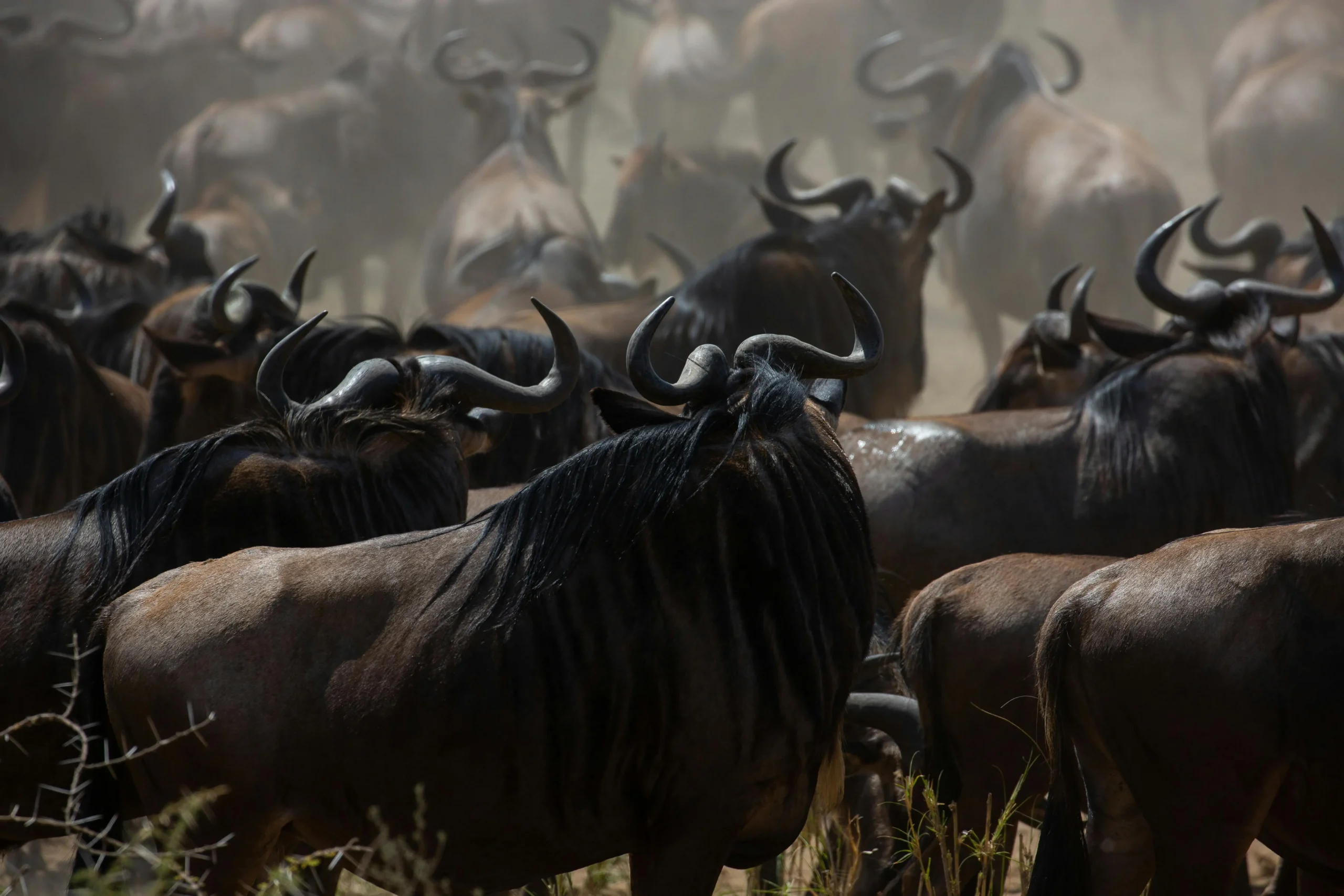Trip Highlights
- Exhaustive safari drives in Masai Mara and Amboseli
- Opportunity to stay in an accommodation close to the Mara river crossing points
- Encounter with giant kili elephants
- Best opportunity to encounter a hunting action
Masai Mara
This is Kenya’s most popular safari destination, characterized by the great wildebeest migration of East Africa, which is one of the world’s most famous overland migrations. The migration in Masai Mara starts in July and ends in September. The best time to view the Mara River crossing is the month of July and the first two weeks of August. This is the most coveted event in the whole migration cycle. Here, the herds take a huge risk plunging into the crocodile infested river. What makes the East Africa migration so unique is that the migrating herds can sustain a consistent clockwise movement all around the year through a distance of 300 miles. To learn about the wildebeest migration right from the calving season in Ndutu plains (January to February), where over 8000 newborns are birthed every day, to the many river crossing debacles, and finally, their return through Eastern Serengeti, the largest cheetah territory in East Africa, follow our migration guide here.
Masai Mara is Kenya’s number one game viewing spot due to its high wildlife density. If you are lucky to stay in the Mara triangle, you are better positioned to view all the big five within a 2 km 2 area.
Best time to visit Masai Mara
Due to the high wildlife density, Masai Mara is a great vacation spot all year round. However, the dry months of December to March and June to August are the best for game viewing. July to August is the best for the migration safari.
Where to stay in Masai Mara
The Masai Mara has the best accommodation infrastructure in kenya, offering different options that give the best of that group safari.
Inside the Mara triangle
The Mara triangle is the southwest part of the Masai Mara, neighboring Mara River to the south and Siria escarpments to the west. The Mara River acts as a buffer that prevents the wildlife from crossing to Tanzania, making it a great place for game-watching. The triangle is also the entry point of the wildebeest and is the best spot for watching the much sought-after river crossing.
Like the Mara Conservancies, the Mara Triangle restricts the number of people sighting an animal, giving you the desired closeness to nature, which is the epitome of an African bush safari.
Only two accommodation facilities are inside the Mara Triangle: Little Governors Camp and Mara Serena Lodge. However, there are other premium facilities like Angama Mara camp perched on top of the escarpments from where you can access the triangle via Oloololo gate.
Inside the Mara conservancies
Masai Mara has over 10 conservancies. The Mara conservancies are the best for honeymooners who want that exclusive stay from the crowds in the main reserve during the migration season. Only guests booked in the conservancies can visit. In addition, the conservancies are characterized by few hotel facilities and a limited number of guests at any given time. The conservancies encourage distancing between safari vehicles to boost the guest experience. Notably, the Mara conservancies neighbor the main reserve’s unfenced border, and therefore, the wildlife roams freely between the wildlife areas. The conservancies also feature a group night game drive that helps you track the hunting process, as most nocturnal predators like lions are awake for the action.
The only limitation of the private reserves is that they do not border the Mara River, denying you the opportunity to view the famous river crossing. However, the conservancies, like the main reserve, are booming with wildebeest during the season. It is also important to note that, despite having paid a concession fee in the conservancy, you will be required to pay another 80 USD to access the main reserve. However, there is not much of a need to visit the main reserve as the conservancies have a better wildlife view.
Outside the Masai Mara main reserve
These are budget facilities perched on the borders of the main reserve. At vocational safaris, we only recommend facilities near the eastern gates of Masai Mara. These facilities are likely the only option for that last-minute booking, especially in the high season. These include Enkorok Mara Camp, Amani Camp, and Mara Sopa Lodge
Amboseli
This is Kenya’s second most popular destination. The southern kenya attraction is famous for its giant African elephant and the magnificent view of Mt Kilimanjaro, Africa’s highest peak. The observation hill, also referred to as the poachers’ hill, situated right at the center of Amboseli, is the only elevation in the national park and provides a great viewpoint of the Amboseli plains.
The best time to visit Amboseli
Although Amboseli is a great place to visit all year round, the dry seasons of January to February and June to August are the best for game viewing. During this period, Amboseli is seemingly empty with only a few remaining grazing lands on the base of Kilimanjaro, where an underground water flow keeps the area wet and green throughout the year. As per this trip, the morning game drive on the second day in Amboseli will be the best moment for your game drive as you will more likely encounter huge herds of elephants time going up to over 100 elephants transcending the dusty jungle. Wildlife prefers walking in the morning to evade the scorching sun.
The program
Day 1 : Nairobi – Masai Mara game reserve
Our driver will arrive at your hotel at exactly 0730 hrs. After a short briefing about the trip, you will drive southward towards Masai Mara. The journey is marked by beautiful sceneries on the rift valley floor. You arrive at Masai Mara at around 1300 hrs, where you are checked into your hotel, after which you proceed for a game drive upto 1800 hrs.
Day 2: Masai Mara game reserve
You wake up at 0600 hrs and take your breakfast. At around 0630 hrs, you proceed for a game drive. A balloon ride can be offered at extra charges. You will go back to the hotel and have lunch, after which you can opt to visit a Masai village or go for a game drive till evening.
Day 3: Masai Mara- Amboseli
You will have a morning game drive upto 10 00 hrs, after which you proceed to the hotel where you check out of the hotel. At 1030 hrs, you will start the journey to Amboseli via Nairobi. You arrive at Amboseli in the evening when you are checked into a hotel where you spend the night.
Day 4 Amboseli
The whole day is reserved for a game drive in Amboseli. We have an opportunity to hike the observation hill where, with a pair of binoculars, we will be able to have a view of birds in the southern marshlands.
Day 5: Amboseli – Nairobi
We check out at our hotel and start our journey to Nairobi. We arrive at Nairobi at around 1100 hrs.
Price Table
| Season | Budget | economy | Luxury |
|---|---|---|---|
| Wet Season | 1300 | ||
| High Season | |||
| Peak |
Children under 3 years stay for free, while kids aged 3–12 enjoy a 75% discount when sharing a unit with their parents.
However, family units are limited in many African safari destinations. If you’re considering a private house, private camp, or interconnecting rooms, availability may be limited. In such cases, our safari specialists will assist in securing a spacious double room that can be converted into a family-friendly space, but only with your consent.
What the Rates include:
- All game drives
- Masai Mara park fees (except when you are staying in a conservancy)
- Conservation fees for those staying in a conservancy.
- Full board accommodation
Excludes
Anything else not included in this program

